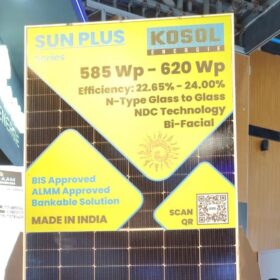pv magazine: With the government implementing anti-dumping duty on materials like solar glass and ethylene vinyl acetate (EVA) sheets, what will be the impact on the domestic industry?
Sunil Rathi: The anti-dumping duty on solar glass and EVA sheets will have a dampening effect on the domestic manufacturers. It would result in the production becoming economically challenging.
Though India currently has a manufacturing capacity of 8 GW, the country doesn’t have sufficient manufacturers to meet the demand. With the increase in demand, domestic players would need to upsurge their supplies, resulting in a possible price hike as it would become a necessity to import raw materials. We believe that achieving economies of scale may be the silver lining for the industry.
pv magazine: What’s your take on the safeguard duty on solar panels? Has it delivered the intended benefits?
Sunil Rathi: In spite of the success achieved by the country over the last few years, there are still some policy related challenges. In order to be economically competitive with the international counterparts, it is necessary to have favourable government policies and subsidies; programmes in place will set a level playing ground for the domestic manufacturers.
India-made modules are already gaining momentum both nationally and internationally. The imposition of safeguard duty on solar imports from China and Malaysia acted as a boost for the domestic manufacturers, giving them the advantage of showcasing their products in front of the international as well as national market.
At the same time, while safeguard duty has been imposed on solar cells and modules from China and Malaysia, these are being rerouted through countries like Thailand and Vietnam.
In order to sustain amongst the international giants, Indian manufacturing sector requires imposition of uniform GST rate across the nation and more stringent regulations on safeguard duty and anti-dumping duty.
pv magazine: In this scenario, do you see Chinese and Malaysian players coming to India?
Sunil Rathi: The Government’s support towards transitioning India to sustainable energy can be seen in their ambitious renewable target of ‘227 GW by 2022’ with 100 GW from solar, which came following the Paris Climate Agreement in 2015.
Also, the ‘Make in India’ initiative by the Government has encouraged the domestic manufacturers to set foot in the international market and also opened up a lot of opportunities in terms of job creation.
We anticipate Chinese and Malaysian players setting up manufacturing hubs in India, thus promoting the ‘Make in India’ initiative.
pv magazine: With solar panel and cell imports soaring from Thailand and Malaysia, how can Indian manufacturers stay competitive and find markets for their products?
Sunil Rathi: The solar module manufacturing market has been primarily dominated by China and we don’t foresee any solutions until an effective policy like anti-dumping is imposed.
The recent approval of 12 GW of new solar projects using domestically-made equipment has come as a relief to the domestic manufacturers and can provide them a level playing ground to compete with their international counterparts. The short-term benefits are, however, moderate. It becomes difficult for mid-scale players to sustain themselves as the move doesn’t provide them immediate support.
This content is protected by copyright and may not be reused. If you want to cooperate with us and would like to reuse some of our content, please contact: editors@pv-magazine.com.









By submitting this form you agree to pv magazine using your data for the purposes of publishing your comment.
Your personal data will only be disclosed or otherwise transmitted to third parties for the purposes of spam filtering or if this is necessary for technical maintenance of the website. Any other transfer to third parties will not take place unless this is justified on the basis of applicable data protection regulations or if pv magazine is legally obliged to do so.
You may revoke this consent at any time with effect for the future, in which case your personal data will be deleted immediately. Otherwise, your data will be deleted if pv magazine has processed your request or the purpose of data storage is fulfilled.
Further information on data privacy can be found in our Data Protection Policy.